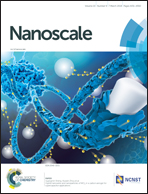CdS nanosphere-decorated hollow polyhedral ZCO derived from a metal–organic framework (MOF) for effective photocatalytic water evolution†
Abstract
Semiconductor nanostructures have received considerable attention in the field of photocatalytic hydrogen evolution. However, eco-friendly, high efficiency, and low-cost semiconductor materials are still desired. In consideration of this, herein, we design a new and economic noble-metal-free CdS/ZnxCo3−xO4 (CdS/ZCO) nanohybrid photocatalyst using a metal–organic framework (MOF) template, which is a framework structure composed of organic ligands and metal ion nodes with different numbers of connections. The as-prepared CdS/ZCO composites with a large specific surface area and porous hollow structure exhibit remarkable catalytic activity and high stability for hydrogen generation. The hydrogen evolution rate is about 3978.6 μmol g−1 h−1 with lactic acid as the sacrificial agent when the optimized amount of CdS nanoparticles (30 wt%) is decorated on the ZCO frame, and the production efficiency of H2 for CdS/ZCO is 4 times higher than that for CdS nanospheres or CdS/Co3O4. The significantly enhanced photocatalytic activity of CdS/ZCO is attributed to the efficient charge separation and transfer between the phase boundary of CdS and ZCO. In addition, the composites exhibit better hydrogen production in lactic acid than in methanol, and the remarkable catalytic activity and high stability of the CdS/ZCO composites for hydrogen evolution indicate that MOF-based composite materials have potential application prospects in energy conversion.



 Please wait while we load your content...
Please wait while we load your content...